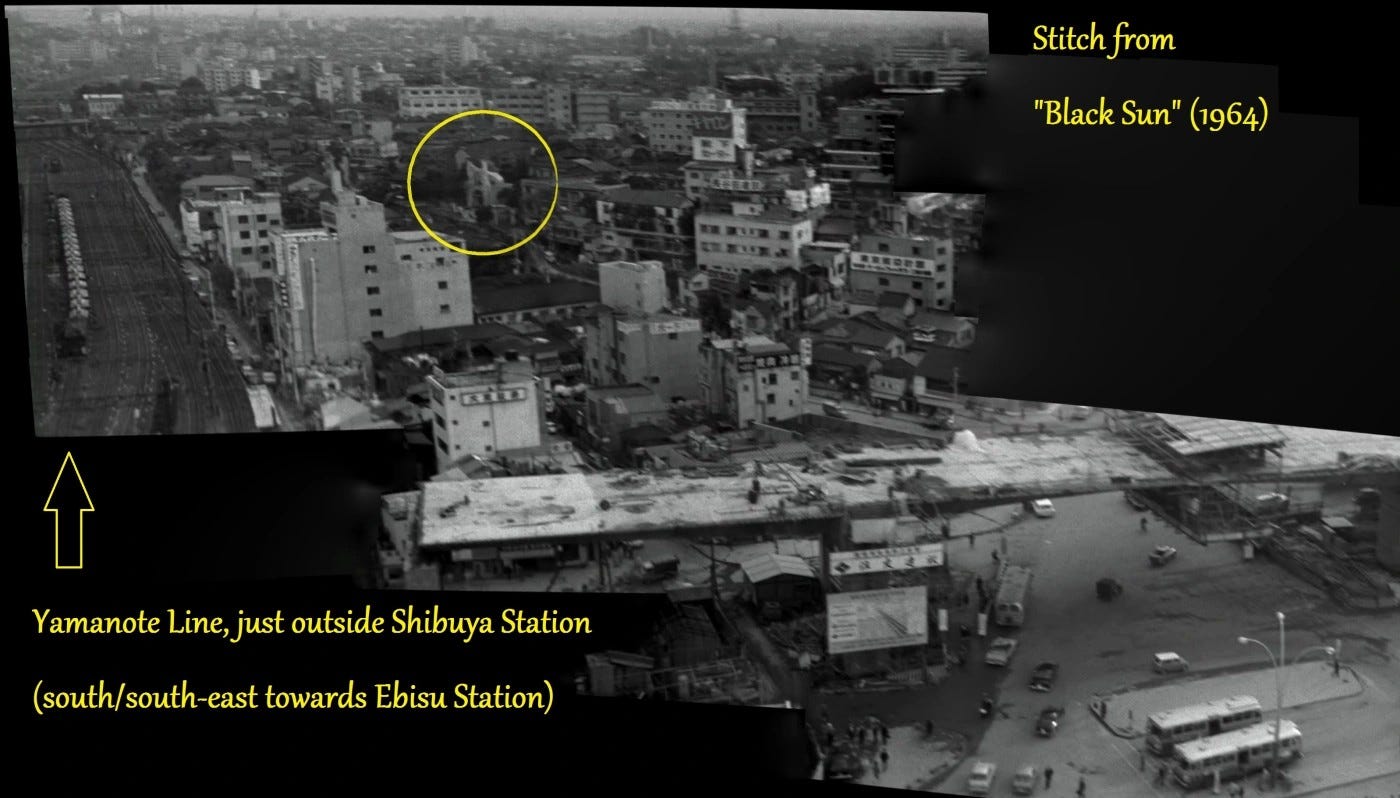Dear readers, last time, Shibuya Station looked like in the short video above. Today we are slowly moving southward toward Ebisu, the next station on the Yamanote Line.
Don’t forget the special 80% discount on annual paid subscriptions.
$30 → $6 (see link above)
Here’s a chance to support Tokyo Calling for cheap.
The district rising on the other side of Ni-Yon-Roku used to be my territory. Here, in Sakuragaoka-cho (Cherry Tree Hill), is the school where I taught Italian for more than 20 years. Until the end of the Pacific War, one of these narrow winding slopes led to the Naka-Shibuya Church, part of the United Church of Christ in Japan (UCCJ), which is the largest Protestant denomination in the country.

The church’s major claim to fame, so to speak, is its appearance in the 1964 film Black Sun. By that time, it was falling to pieces and cut a stark, eerie figure amid the bustling new city reborn after the war. The film portrays the complex relationship between a jazz-obsessed Japanese drifter and thief who lives in the church and an African-American soldier on the run from the police, and the place serves as a significant backdrop, symbolizing the cultural and emotional intersections between the two men, underscoring themes of alienation, redemption, and the search for connection in postwar Japan.
In an excellent review of the film, David Blakeslee writes:
“Besides the swingin’ soundtrack and the bizarre fascination stirred up by Gil and Mei’s interactions, Kurahara’s unique eye for composition and his camera’s free-flying movements supply the other compelling reason to give Black Sun a spin. I’m assuming that the blasted husk of a church was a real location, not a fabricated set, but even if it wasn’t, Kurahara’s exploration of the building’s desecrated interior and rickety assembly of ladders and staircases is quite marvelous to behold. The angles are so acute and unusual that it often takes the eye a few moments to decipher what it’s looking at, lending the film some decent replay value.”
The building we see in the film was erected in 1917 by Pastor Mori Akira. He was the third son of Mori Arinori, Japan’s first Minister of Education, who was unceremoniously stabbed to death by an ultranationalist in 1889.
The original church is long gone, having been demolished during filming of Black Sun in 1964 (its latest version, completed in 2020, can be found not far from there). By the time I came to Japan, that location had become the site of Yamaha Electone City Shibuya, a Yamaha concert hall.
I was planning to end my walk around the Yamanote Line on that same spot. I could already see myself standing there, having come full circle, looking in the distance at the skyscrapers, reflecting on Tokyo's dynamic cultural landscape while trying to come up with some religious metaphor. Alas, that corner is nowhere to be found, having been replaced by a construction site – another bulky box of ferroconcrete.
I ask a security guard – a sad-looking guy in his late 60s or early 70s – and he tells me that the whole complex, called Shibuya Sakura Stage, should be opened in August 2024 – the annexed hotel a little earlier. Two buildings, respectively 39 and 30 floors high, connected by a deck, are being built on a 2.6-hectare site – the huge hole I had seen from the pedestrian overpass while trying to locate the ramen shop.
This is the last of the large-scale redevelopment projects carried out by the Tokyu Group and others around the station. Like the other buildings, it will include offices and commercial stores (this one will accommodate 10,000 people) as well as residences and service apartments for medium- to long-term stays. “The facility,” recites the press release, “aims to become a hub for the unique Shibuya culture, blah blah blah,” same old empty talk.
Shibuya is home to many IT companies, and while there have been many vacant offices due to remote work during the COVID-19 pandemic, more than 90% of the office space within Sakura Stage has already been leased to IT and gaming-related companies. At the preview, Tokyu Real Estate President Hoshino Hiroaki said, "We want to further enhance the power and appeal of the Shibuya area and play a part in the growth of the Japanese economy."
Here’s Black Sun with English subtitles. Some parts, like the opening sequences, are shot documentary style and give you a good idea of how Tokyo and Shibuya in particular looked just before the 1964 Olympics.







Thank you for the Black Sun link. Will watch it tonight.
Hello G.S.
43 years here in the Tokyo area, and other than work, Shibuya used to be the main reason I visited the Yamanote loop ... but for reasons few would guess.
Prior to the recent pre-Covid era construction boom, Shibuya was the home to 'Jumbo' Joshuya ... probably the largest single fishing tackle shop in Japan ... three floors of more than you can study, sift, and buy tackle to catch anything that swims in Japanese waters ... from wakasagi to hon maguro.
There are still small, scattered 'boutique' shops such as Sansui in the area, but as a long-time fisherman (had a string of 7 off-shore boats — 'holes in the water through which you pour money'), Shibuya has sacrificed my church to the altar of 'progress'.
Cheers!